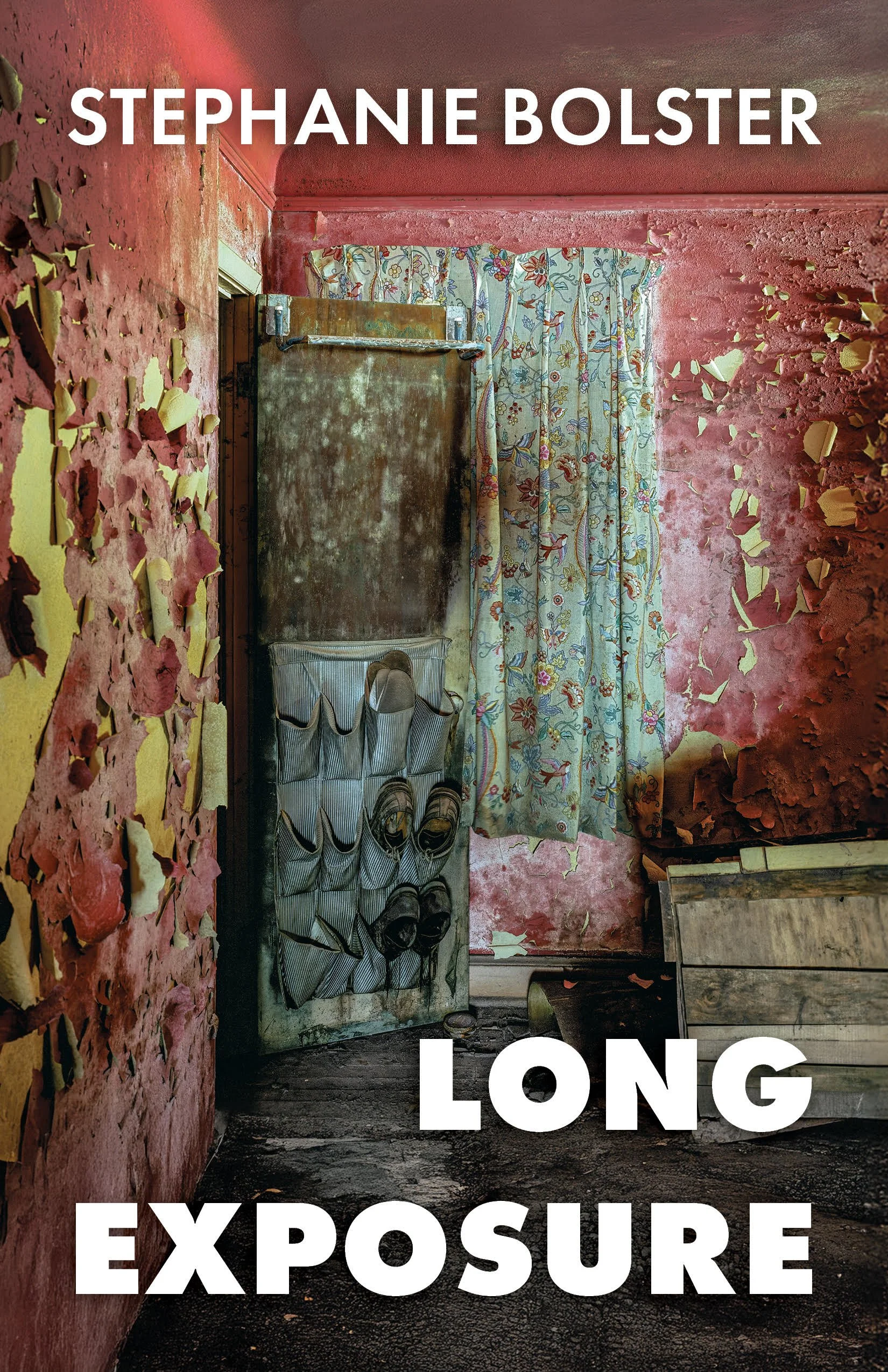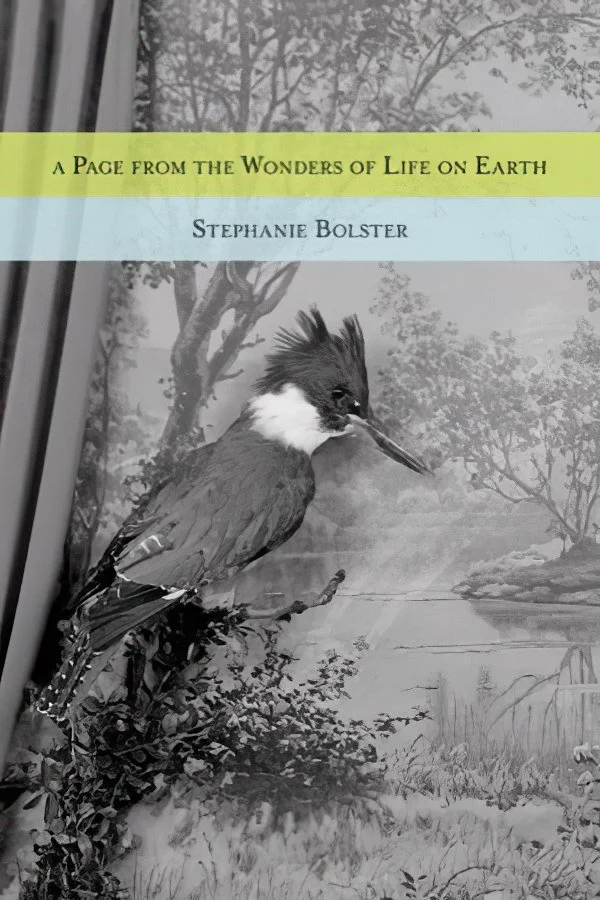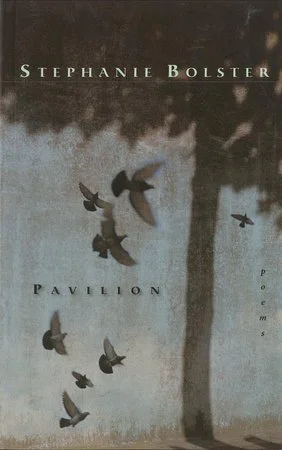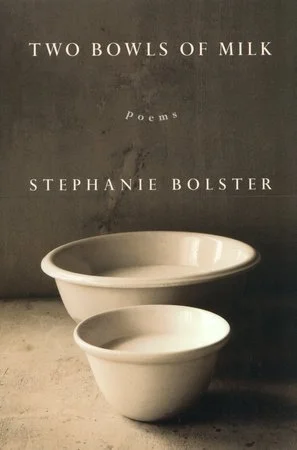
Books
Long
Exposure
(Palimpsest Press, 2025)
A roaming, associative exploration of disasters and their ongoing aftermaths
After Hurricane Katrina, the photographer Robert Polidori flew to New Orleans to document the devastation. In the wreckage he witnessed, and in her questions about what she saw in what he saw, Stephanie Bolster found the beginnings of a long poem. Those questions led to unexpected places; meanwhile, life kept pouring in. The ensuing book, Long Exposure, is Bolster’s fifth, a roaming, associative exploration of disasters and their ongoing aftermaths, sufferings large and small, and the vulnerability and value of our own lives. Incremental, unsettling, Long Exposure rushes to and through us.
“A lyric pulled apart … Far more confident, mature; more open and adventurous.”
- rob mclennan
“Elegiac, moving, and unsettling …”
- Madelaine Caritas Longman,
Montreal Review of Books
Review of Long Exposure
by rob mclennan
“Weather is Not Our Friend:”
Review of Long Exposure
in The Woodlot
“Art in the ruins of the world:”
Review of Long Exposure
in British Columbia Review
A Page from
the Wonders
of Life on Earth
(Brick Books, 2011)
Finalist for the
Pat Lowther
Memorial
Award
An ambivalent zoo-tour, an open-eyed meander through a landscape of made and contained things
A Page from The Wonders of Life on Earth is a book with a coherent vision of nature — constructed or framed, both in the present and in the recent past—through zoos, aviaries, formal gardens, menageries, and books like the Time-Life one named in the title. Informed by the author’s grand tour of these zoos and gardens, these poems provide a strong lens for considering the many paradoxes of inter-species relations; they open up the possibility of honest, unsentimental elegy. The book is also a model of what might be called investigative poetry, taking the poet’s combination of perceptual acuity, craft, music and sensibility into these richly troubled places (prisons of, monuments to, museums for the lost natural world) where “arcades sell postcards of old photographs of the arcades,” and where questions of what it means to be human, to be animal, to be other and to be art are tangibly in the air.
“Densely researched, cosmopolitan,
and delicately wrought…”
- Nick Thran,
Quill & Quire
“The thrill of this collection, her fourth, is in the way it perches (and invites readers to perch) so precariously in places at once familiar and strange … Bolster’s readers will appreciate poetry that transports them to such curious places and so delicately suggests, as a floor made of glass might suggest, new ways of seeing the world.”
- Moberley Luger,
Canadian Literature
“In Stephanie Bolster’s [book], the writing is acutely compressed, each word standing in for what in another poet’s hands might take pages. There’s no room for sentimentality. These poems have been tightened like the lug nuts on a racecar.”
- Barry Dempster,
Open Book
“This is a book which, under the guise of looking at man’s confining attitude to the natural world, meditates profoundly on the contemporary condition. It is further confirmation of Stephanie Bolster’s status as one of Canada’s finest younger poets.”
- Ian Pople,
The Manchester Review
“Bolster has a quiet confidence and a way of twisting illumination into a poem that is deeply compelling. Her pacing is exquisite, engaging readers with apparent simplicity that turns into beautiful complexity at the flick of a line.”
- Candace Fertile,
Maple Tree Literary Supplement
Pavilion
(McClelland & Stewart, 2002)
The poems in Stephanie Bolster’s collection create longings, reveries, and meditations that, though powerfully presented to us, evade the reduction of named emotion. It takes a special subtlety of writing, a delicate handling of image and judgment of details to make what is offstage resonate with such eloquence. This collection reveals Stephanie Bolster writing at the extreme of her craft to bring us a poetry of extraordinary refinement.
“… The enterprising brevity of the writing – where all the tiny unsentimental surges of regret flourish into a work of considerable sophistication – may make Pavilion one of the most talked-about collections of the year.”
- Carmine Starnino,
Montreal Review of Books
“Impressive not just for the pieces, but how the book as a whole is built, Bolster writes with a violence and a real sadness that infuses this new work ...”
- rob mclennan,
The Danforth Review
Two Bowls of Milk
(McClelland & Stewart, 1999)
Winner of the
Archibald
Lampman
Award
The poems of Stephanie Bolster’s second collection move with delicacy and power, whether focussing on a flock of snow geese on a flooded plain, on the paintings of Jean Paul Lemieux, or on two wasps in a Pepsi can on the steps of the Metropolitan Museum of Art. These intimate acts of language create a space infused with stillness and an edgy expectation. Here is a poetry of engagement and mystery, in which truth is found in seepage and reversal: the bowls of milk the colour of milk; the two facing human profiles forming between them the shape of a vase. This volume sketches a clear, unwavering arc through poems sometimes raw and painful, but always exquisite, and, ultimately, transformative. Two Bowls of Milk confirms Stephanie Bolster as one of the most gifted new poets in Canada today.
“These bowls reveal the delicate discrimination of Bolster’s vision … These are strong, supple poems, yet evocative, like earth-stained hands playing a game of catch underwater with a feather.”
- Jennifer Duncan,
Quill & Quire
“[Bolster’s] poems work with a voice so at ease and natural that their insights seem at once familiar and new, the way summer rain announces itself just before it falls.”
- Montreal Gazette
“What a startling voice she has…”
- Patrick Lane,
Vancouver Sun
White Stone:
The Alice Poems
(Véhicule Press, 1998)
Winner of the
Governor
General’s
Award
These evocative poems move from the icon of Alice in Wonderland to the imagined figure of Alice out of Wonderland--on a Vancouver beach with the poet, underground with Persephone, in Memphis with Elvis. But first they explore the life of the real Alice Liddell (1852-1934), who sat still for Charles Dodgson's camera and inspired the Alice books which prompted his rise to fame as Lewis Carroll.
"WHITE STONE: THE ALICE POEMS was judged the best book of poetry in 1998 for as many reasons as there are poems in this powerful sequence, but due primarily to Stephanie Bolster's ability to depict the emotional life of Alice Liddell as girl and woman in brilliant narrative juxtapositions. She uses her lyrical powers to present Alice the creation and Alice the person in a cultural context that, on one level, re-examines cognition and dissociation and on another, liberates the poetic sequence from the monotony of story and closure."
- The Governor General Award
Jury Citation
“Bolster simply dazzles with technical virtuosity…”
- Judith Fitzgerald,
Toronto Star
“Bolster is the painter’s poet … crafting lines that hold and haunt in indelible images.”
- Ottawa X Press
White Stone: The Alice Poems
translated into French by Daniel Canty:
Pierre blanche: Poèmes d'Alice
(Noroît, 2007)
Honourable
Mention for the
John Glassco
Prize
Dans son journal, Charles Dodgson marqua d’une «pierre blanche» le «jour chanceux» de 1856 où il fit la connaissance de la petite Alice Liddell. Le révérend et la petite fille d’Oxford sont alors entrés ensemble au Pays des merveilles, laissant leurs corps et le temps derrière pour devenir, entre les pages d’un livre, Lewis et Alice. À un siècle et demi de distance, la poète piste les mouvements intimes de ces êtres réels et rêvés, qui continuent d’exister au carrefour des mondes, en poursuite perpétuelle de leurs doubles. Il y a le voyage d’Alice, mais le merveilleux ne tient pas là. Il réside dans le fait que la poète prolonge l’espace d’Alice jusqu’à l’inclure dans ses éléments biographiques. Si bien que les deux vies dialoguent et s’entrecroisent. Poursuivant l’amusement comme si elle entrait dans l’ombre de l’histoire et que les fantômes prenaient la forme d’un jeu de «cache-cache», «Les poèmes sont des scènes des vies réelles et rêvées d’Alice Liddell et de la poète…»





